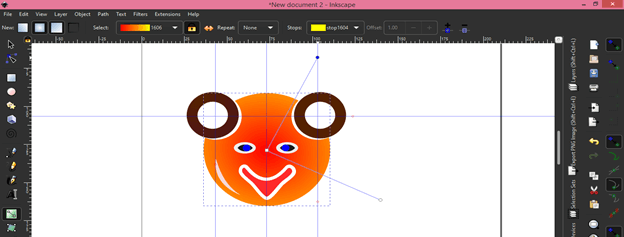
- #CREATE CUT VECTOR AND ETCH VECTOR INKSCAPE HOW TO#
- #CREATE CUT VECTOR AND ETCH VECTOR INKSCAPE CODE#
- #CREATE CUT VECTOR AND ETCH VECTOR INKSCAPE SERIES#
The most important ones are arguably G (used in most movement commands), M (miscellaneous commands), X, Y and Z (the last three are used to define positions in the X,Y,Z space, absolute or incremental). These letters corresponds to different types of commands.
#CREATE CUT VECTOR AND ETCH VECTOR INKSCAPE CODE#
Everywhere you look in the code you will mostly see letters with numbers behind them. A CNC mill interpreting G-code in real-time Structure and CommandsĮach new line (called block) in the G-code can be roughly regarded as a new command. G-code has many dialects or variants, but most (or all) adhere to certain common rules. G-code is the most widely used programming language for controlling industrial machines such as mills, lathes and cutters as well as 3D-printers.
#CREATE CUT VECTOR AND ETCH VECTOR INKSCAPE HOW TO#
As a natural continuation from last week, we’re now going to talk about such toolpaths, called G-code, and how to generate those in Inkscape. The third suggestion on why to do such a thing involved creating toolpaths for machines. A depth of engraving will always be within a tolerance of +/-0.2mm.In last week’s post we discussed how to create vector graphics from bitmaps in Inkscape. Achieving a certain depth is a balance in variation between the laser power and speed. Raster and vector engraving is not absolute science in terms of depth specification and therefore not suitable for making mechanical grooves or any features requiring precise depths. It is achievable, but the laser has to run slowly meaning the concentrated heat build up makes the material appear quite burnt / heat scorched. Up to 2mm is considered deep for most materials: 0.25 microns (depending on material) and has excellent legibility. In laser terms depth is usually specified in microns. If you would like to achieve a deeper result or an engraving a little heavier let us know your specification. The Strokes & Fonts sample on the material pages demonstrates the clarity achievable on each material. In raster engraving terms the marking is cosmetic, shallow and typically a balance between legibility and cleanliness. We have established optimized settings for all materials. Raster engraving standard appearance & depth

When arranging artwork for engraving that has a few components on one sheet, it’s best to keep all of the raster engraving as close together as possible and in a horizontal row. Set all fill colours to: Black: RGBA: 0,0,0,255.Select your line and select Path > Stroke to path command.Set strokes to a minimum of 0.40mm (anything thinner won’t engrave).To turn a line into a filled shape in Inkscape: All vectors you would like raster engraved must be indicated by a vector fill. While we can raster engrave thin vector lines, it’s advised that you vector engrave/ score them. If you have elements of your drawing that will only fit onto a large template but don’t need to use a whole sheet, just leave the remaining areas blank. Cutting & engraving densely populated files over large areas can cause the material to warp during the process.
#CREATE CUT VECTOR AND ETCH VECTOR INKSCAPE SERIES#
If you have lots of small components from the same material it’s best to draft these on a series of smaller templates approximately 1000mm x 500mm rather than on one large template. if your components can fit within a 1000mm x 500mm template, don’t position your drawing on a 2000mm x 1000mm template with lots of excess.

Try and use templates that suit best the scale of your drawings. If you want parts cut / engraved from multiple materials, Use the corresponding templates for chosen material Template sizes If you want all your parts cut / engraved from the same material, arrange into multiples of the same templates and draw as many as required.

Working with the drawing templates Multiple files from same material Once downloaded, select and open the sheet size that is large enough for your components. Templates for Inkscape can be downloaded from our templates page. Materials come in all different sizes depending on the maximum sheet size supplied from the manufacturer. They help to verify scale and material type. If using our materials, we recommend downloading our drawing templates.


 0 kommentar(er)
0 kommentar(er)
